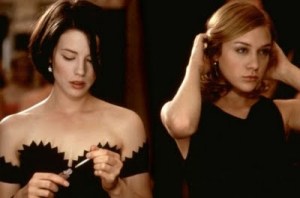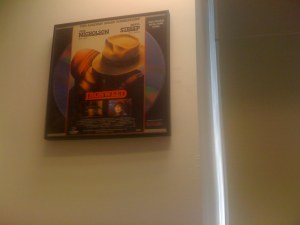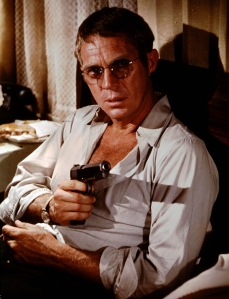
It wasn’t hard to track down Whit Stillman. Though it was hard to get a word in.
Before the screening of Stillman’s The Last Days of Disco at The Film Society of Lincoln Center, I hoped to find the director, introduce myself and ask for a couple minutes after the screening for a “brief” interview.
But finding the chronicler of the so-called “urban haute-bougeoise” (his term), proved fairly easy: all I had to do was look for the man in the impeccable suit.
“Mr. Stillman,” I asked. “If I could grab a moment of your time, I’m Nicholas, I’m a reporter for the filmlinc blog–”
“Ah, great.” He told me graciously. “So nice to meet you, Nicholas. This is Tara, she’s in the film.”
A blond woman curtsied. I shook her hand too.
“Ah yes, very nice to meet you, but Mr. Stillman–”
“And this is Mark, the composer.” Mr. Stillman put his hand on the shoulder of a shy gentleman who gave a wave.
I tried to interrupt again.
“And this is…”
And so it went.
This social etiquette is not just a function of Mr. Stillman’s personality, but also eminently of his films. In his Academy Award-nominated film Metropolitan and in the later Last Days of Disco (recently released on Criterion), Mr. Stillman produces portraits of sheltered WASP-y New Yorkers in their mid-twenties growing up on the Upper East Side (Indeed, in Metropolitan, the banishment of one of the characters to Manhattan’s Upper West Side is a source of great shame in the film). These characters, sometimes characterized as “debutantes”, sometimes as “yuppies,” all show impeccable good manners even when savaging each other verbally, as they often do throughout the films. Mr. Stillman’s style is extremely distinct, his films are truly unmistakable, and his characters qualities have more often been compared to the protagonists of Jane Austen novels than other filmic protagonists. His style incorporates both humor and compassion for the hapless/helpless Manhattan socialites he portrays.
And as I waited to speak to him, introduced to his filming companions, I realized that this was more of his style: that he introduces the characters and then let’s them speak for themselves.
When I got to him after a long line of adoring fans had approached for DVD signing, I managed to sneak in a few questions.
“You were popular in there,” I told him, as I snuck him out to the Walter Reade balcony.
“I wish I were that way in Hollywood,” he said modestly, drink in hand.
“I’ve heard you compared to Woody Allen, in terms of your style and intimacy with your well-to-do characters,” I informed him. “But then again, sir, I don’t think I’ve ever seen a Jew in any of your movies.”
“Guilty as charged,” he replied. “I love Woody Allen and he’s certainly an influence. But he’s like a savant and I’m like a dyslexic; he keeps up the pace constantly creating, a movie a year, while I seem to come out with them on occasion. But Allen often seems to break reality in his films and I try to stay there”
He continued: “I’ve been accused of naturalism,” he said, as if naturalism were a crime. “But, I’d like to think that people who are “naturalistic” are often on the wrong side of things. When I was making one of my films, we had to have a scene through a car windshield and my director of photography asked me if I wanted to fake the glare that might be in the windshield to make it seem more ‘natural’. I told him no, I didn’t care about that, I wanted to see the actor’s faces. I feel that the stronger part of reality is the emotional truth of how we connect to people, to characters. The expressions on the actor’s faces, that’s reality to me, much more important than a glare on a car windshield.”
“But what about fiction, sir?” I asked. “You got your start there, much like some of the characters in The Last Days of Disco. What’s the difference between a story told in fiction and one in film?”
“Well I got to meet Tom Wolfe,” He said. “And he told me what he thought the difference was. That in fiction you cant talk about someone’s shoes. You can talk about someone’s mannerisms, while if you did that in a film, there’s no room for it, if you lingered on a pair of shoes, people would think you were weird.”
At this point, I was interrupted by more of Mr. Stillman’s guests who came to greet him and say good night, as I realized that he is very much a part of the social community still that he writes about, shoots about, and gently mocks.
“Before you’re swept away,” I asked. “Any advice for the writers and filmmakers of today?”
“Don’t watch too many movies.” He said. “After all, there’s life out there to live.”
At which he was taken away back into the crowd.
-Nicholas Feitel


























Muse of the “Metropolitan:” A (Short) Conversation with Whit Stillman
August 28, 2009It wasn’t hard to track down Whit Stillman. Though it was hard to get a word in.
Before the screening of Stillman’s The Last Days of Disco at The Film Society of Lincoln Center, I hoped to find the director, introduce myself and ask for a couple minutes after the screening for a “brief” interview.
But finding the chronicler of the so-called “urban haute-bougeoise” (his term), proved fairly easy: all I had to do was look for the man in the impeccable suit.
“Mr. Stillman,” I asked. “If I could grab a moment of your time, I’m Nicholas, I’m a reporter for the filmlinc blog–”
“Ah, great.” He told me graciously. “So nice to meet you, Nicholas. This is Tara, she’s in the film.”
A blond woman curtsied. I shook her hand too.
“Ah yes, very nice to meet you, but Mr. Stillman–”
“And this is Mark, the composer.” Mr. Stillman put his hand on the shoulder of a shy gentleman who gave a wave.
I tried to interrupt again.
“And this is…”
And so it went.
This social etiquette is not just a function of Mr. Stillman’s personality, but also eminently of his films. In his Academy Award-nominated film Metropolitan and in the later Last Days of Disco (recently released on Criterion), Mr. Stillman produces portraits of sheltered WASP-y New Yorkers in their mid-twenties growing up on the Upper East Side (Indeed, in Metropolitan, the banishment of one of the characters to Manhattan’s Upper West Side is a source of great shame in the film). These characters, sometimes characterized as “debutantes”, sometimes as “yuppies,” all show impeccable good manners even when savaging each other verbally, as they often do throughout the films. Mr. Stillman’s style is extremely distinct, his films are truly unmistakable, and his characters qualities have more often been compared to the protagonists of Jane Austen novels than other filmic protagonists. His style incorporates both humor and compassion for the hapless/helpless Manhattan socialites he portrays.
And as I waited to speak to him, introduced to his filming companions, I realized that this was more of his style: that he introduces the characters and then let’s them speak for themselves.
When I got to him after a long line of adoring fans had approached for DVD signing, I managed to sneak in a few questions.
“You were popular in there,” I told him, as I snuck him out to the Walter Reade balcony.
“I wish I were that way in Hollywood,” he said modestly, drink in hand.
“I’ve heard you compared to Woody Allen, in terms of your style and intimacy with your well-to-do characters,” I informed him. “But then again, sir, I don’t think I’ve ever seen a Jew in any of your movies.”
“Guilty as charged,” he replied. “I love Woody Allen and he’s certainly an influence. But he’s like a savant and I’m like a dyslexic; he keeps up the pace constantly creating, a movie a year, while I seem to come out with them on occasion. But Allen often seems to break reality in his films and I try to stay there”
He continued: “I’ve been accused of naturalism,” he said, as if naturalism were a crime. “But, I’d like to think that people who are “naturalistic” are often on the wrong side of things. When I was making one of my films, we had to have a scene through a car windshield and my director of photography asked me if I wanted to fake the glare that might be in the windshield to make it seem more ‘natural’. I told him no, I didn’t care about that, I wanted to see the actor’s faces. I feel that the stronger part of reality is the emotional truth of how we connect to people, to characters. The expressions on the actor’s faces, that’s reality to me, much more important than a glare on a car windshield.”
“But what about fiction, sir?” I asked. “You got your start there, much like some of the characters in The Last Days of Disco. What’s the difference between a story told in fiction and one in film?”
“Well I got to meet Tom Wolfe,” He said. “And he told me what he thought the difference was. That in fiction you cant talk about someone’s shoes. You can talk about someone’s mannerisms, while if you did that in a film, there’s no room for it, if you lingered on a pair of shoes, people would think you were weird.”
At this point, I was interrupted by more of Mr. Stillman’s guests who came to greet him and say good night, as I realized that he is very much a part of the social community still that he writes about, shoots about, and gently mocks.
“Before you’re swept away,” I asked. “Any advice for the writers and filmmakers of today?”
“Don’t watch too many movies.” He said. “After all, there’s life out there to live.”
At which he was taken away back into the crowd.
-Nicholas Feitel
Categories: Film Comment, Filmmaker interviews, inside the film society, just for fun, on @ the walter reade
Tags: Metropolitan, The Last Days of Disco, Tom Wolfe, Whit Stillman, Woody Allen
Comments: 1 Comment